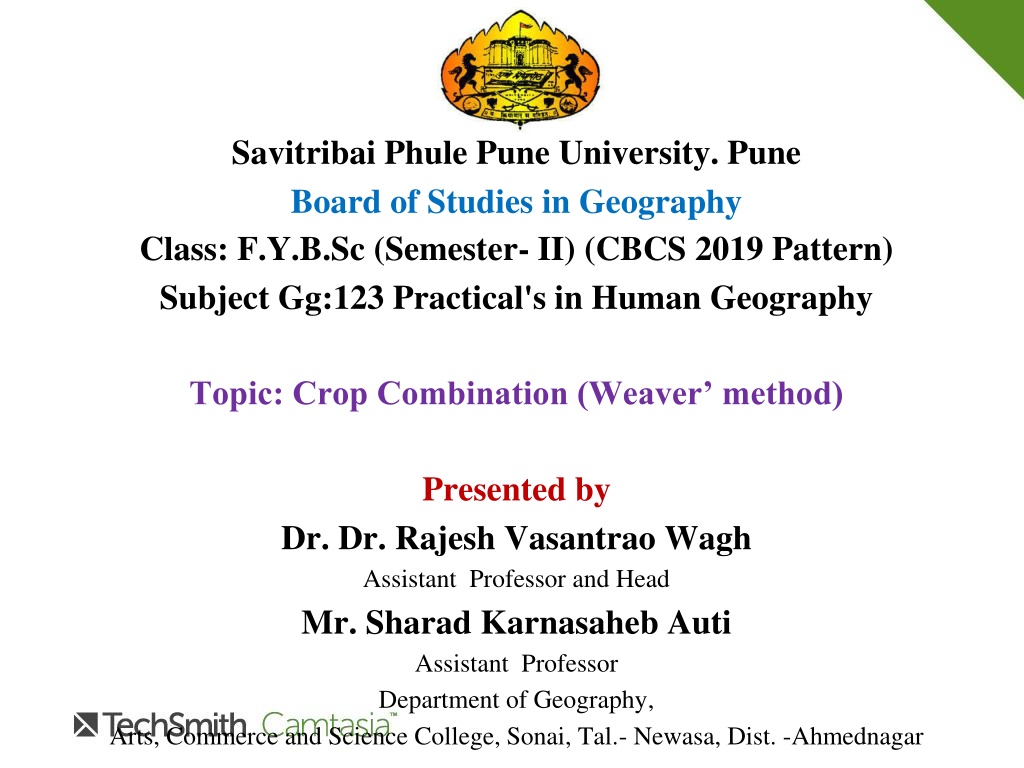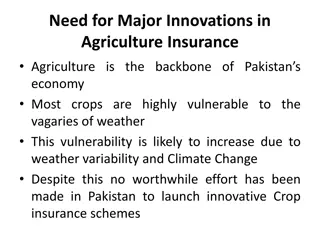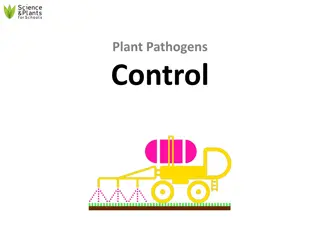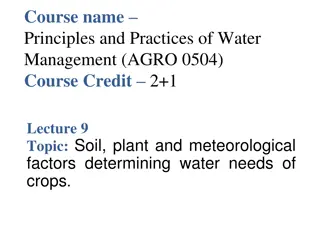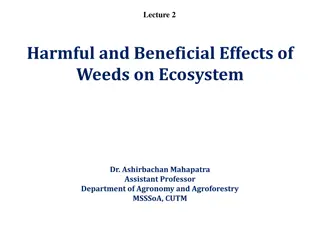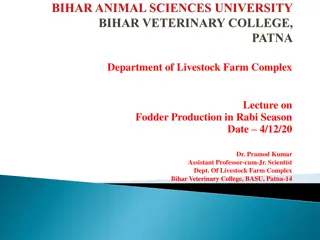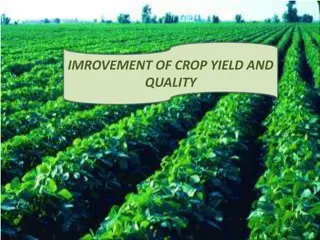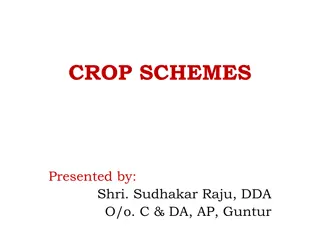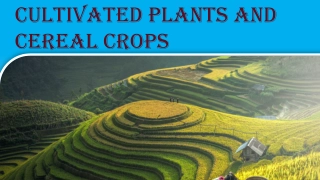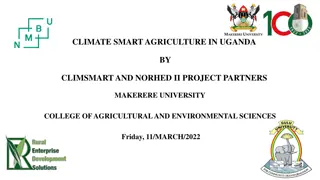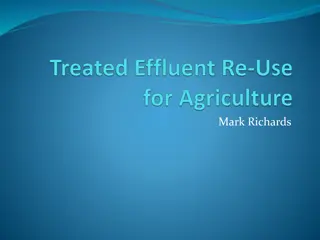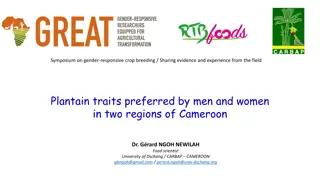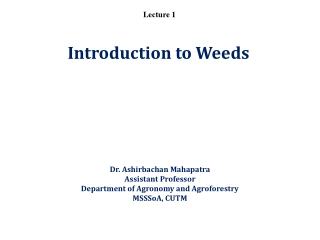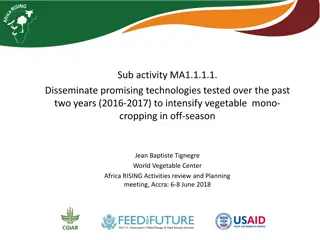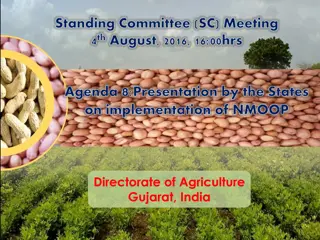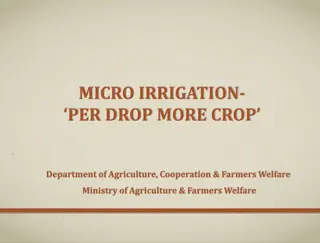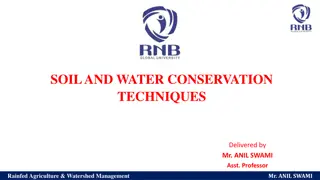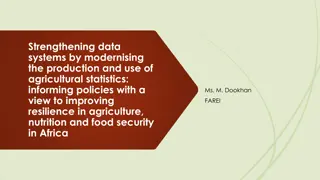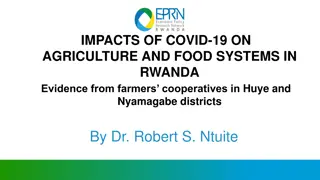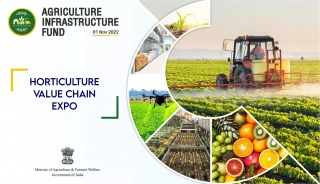Understanding Crop Combination in Agriculture
Crop combination is the practice of growing different types of crops together to enhance productivity, soil fertility, and nutrient enrichment while promoting sustainable farming. This method, popularized by John C. Weaver, analyzes the distribution of various crops in a region to optimize agricultural yield and environmental conservation efforts.
Download Presentation

Please find below an Image/Link to download the presentation.
The content on the website is provided AS IS for your information and personal use only. It may not be sold, licensed, or shared on other websites without obtaining consent from the author. Download presentation by click this link. If you encounter any issues during the download, it is possible that the publisher has removed the file from their server.
E N D
Presentation Transcript
Savitribai Phule Pune University. Pune Board of Studies in Geography Class: F.Y.B.Sc (Semester- II) (CBCS 2019 Pattern) Subject Gg:123 Practical's in Human Geography Topic: Crop Combination (Weaver method) Presented by Dr. Dr. Rajesh Vasantrao Wagh Assistant Professor and Head Mr. Sharad Karnasaheb Auti Assistant Professor Department of Geography, Arts, Commerce and Science College, Sonai, Tal.- Newasa, Dist. -Ahmednagar
What is crop combination? Crop combination is a concept of growing different types of crops under a same field. Crop combination is the analysis of the total percentage acreage area occupied by different crops in a given region in an agricultural year.
For example, (In Kharif season):- One of the most prominent examples of crop combination are the three sisters maize (Grain Crops), beans (Leguminous Crops) and squash (Vegetable Crops). They are called sisters because, just like sisters, they look after each other. [The maize crop provides natural support for bean vines to climb. The bean vines fix nitrogen in the soil, thus making the soil more fertile for maize. The bean vines also hold maize crops, protecting them from blowing winds. The shallowly rooted squash vines act like a living mulch which retain the moisture in the soil. The spiny squash vines also keep predators away from maize and beans. Together these three sisters leave a large number of residues back in the soil at the end of a season, making the soil organically richer, with improved texture.] The three sisters are a largely self-sustaining system that provides long time soil fertility and a healthy balanced diet for generations.
Why do we study crop combination: Crop combination has great importance in the agricultural economy for the following reasons: For good yield, For intensive farming, For nutrients enrichment and environment conservation, For used to classify the agricultural region Used in land utilization and land planning Used to make agriculture policy
Weavers crop combination methods: In the field of agri. Geo. John C. Weaver 1954 was the first to use statistical technique to establish the crop combination analysis in united state.
Weaver calculated hypothetical area for different crops in different combination as-- Combination Hypothetical Area Sr. No 1 Monoculture 100% of total harvested crop land in one crop 2 2 crop combination 50% & 50% area 3 3 crop combination 33.3%, 33.3%, 33.3% area 4 4 crop combination 25%, 25%, 25%, 25% area 5 5 crop combination 20%, 20%, 20%, 20%, 20% 6 10 crop combination 10%, 10%, 10%, 10%, 10%, 10%, 10%, 10%, 10%, 10%,
Steps to calculating the crop combination: First, Arrange the actual crops areas in decrement order Second, Finding the deviation; d = ideal distribution - actual distribution of cropping areas Third, Finding the Crop combination Index for each sample; S= d^2/n Fourth, A sample of having a Minimum crop Combination Index (CI) will be the best crop combination for that region or field.
For the determination of the minimum deviation the standard deviation method was used: Where:- d is the difference between the actual crop percentages in a given county (areal unit) and the appropriate percentage n is the number of crops in a given combination As Weaver pointed out, the relative, not absolute, the value being significant, square roots were not extracted; so the actual formula used was as follows:
Weaver calculated the difference between the hypothetical area (Theoretical) and actual area of each crop in the combination, the difference is then statistically represented with the method of standard deviations. The value of minimum standard deviation of respective crop combination is suggested for that area.
For example:- Apply Weaver method of crop combination for the given data. Sr. No Crop Percentage area 1 Rice (R) 48% 2 Bajara (B) 18% 3 23% Wheat (W) 4 Gram (G) 5% 5 Sugarcane (S) 6%
Solution: Crop arranged in descending order according to their areas- Sr. No Crop Percentage area 1 Rice (R) 48% 2 23% Wheat (W) 3 Bajara (B) 18% 4 Sugarcane (S) 6% 5 Gram (G) 5%
Mono, Crop combination 2 crop combi. 3 crop combination 4 crop combination 5 crop combination Crop Rank 1 1,2 1,2,3 1,2,3,4 1,2,3,4,5 Crops (R) (R), (W) (R), (W), (B) (R), (W), (B), (S) 25%, 25%, 25%, 25% 48%, 23%, 18%, 6^ 23%, 2%, 7%, 19% 529, 4, 49, 361 (R), (W), (B), (S), (G) 20%, 20%, 20%20%, 20% 48%, 23%, 18%, 6%, 5% 28%, 3%,2%, 14%, 15% 784, 9, 4, 196, 225 1218 Theoretical % 100% 50%, 50% 48%, 23% 2%, 27% 14.7%, 10.3%, 15.3% 4, 729 216.09, 106.09, 234.09 733 556.27 33.3%, 33.3%, 33.3% 48%, 23%, 18% Actual % 48% Deviation (d) (100-48) = 52% 2704 2704 943 366.5 185.42 235.75 243.6 2704 / 1 = 2704 19.44 13.61 15.35 15.60
1. 1stcrop = 52 / 100 X 100 = 52 2. 2ndcrop = 19.14 / 50 X 100 = 38.28 3. 3rdcrop = 13.61 / 33.3 X 100 = 40.89 4. 4thcrop = 15.35 / 25 X 100 = 61.40 5. 5thcrop = 16.60 / 20 X 100 = 78.00
Conclusion: In the above table different five combination are worked on for suggesting, the values of standard deviation and coefficient of Weaver shows that the minimum values of both are formed three crops combination i.e. Rice, Wheat, Bajara. In the given area we can suggest that according to Weavers method Three crop combination is suitable
Assignment: What is crop combination? Why do we need to study crop combinations? Explain the Weaver method of crop combination
